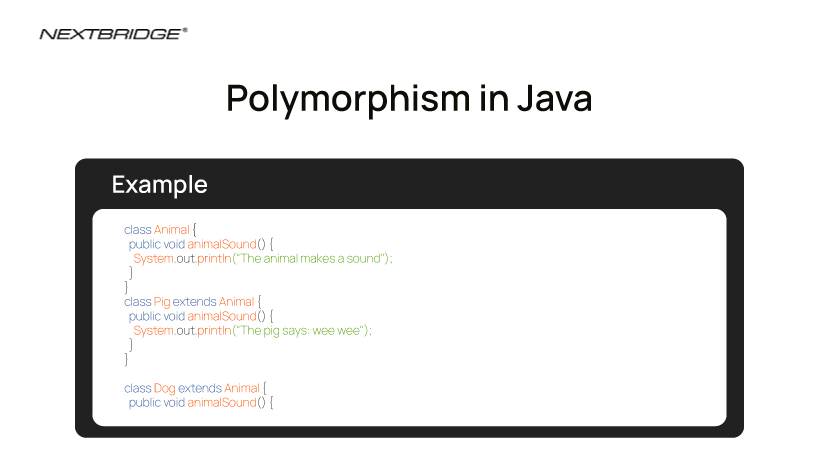When it comes to object oriented programming, polymorphism is a key tool for creating a collaboration between objects so that those in different classes can be treated as objects of a common superclass. It leads to successful development by making the process maintainable and extensible because it allows developers to write flexible and reusable codes.
Therefore, we will delve into the world of polymorphism in Java to explore examples and best practices to harness its benefits effectively.
Understanding Polymorphism in Java
Polymorphism in Java is achieved through inheritance and method overriding, two essential features of object-oriented programming. Establishing an “is-a” relationship allows the subclasses to inherit the behavior of superclasses for flexible designing and this bond can be created by forming a hierarchy of inheritance.
Java Polymorphism Example
Let’s consider a practical example to illustrate Java polymorphism. For instance, you have a superclass named “Shape” and two other subclasses named “Circle” and “Rectangle”. Each subclass overrides the “calculateArea” method defined in the Shape class. It is at this stage that we will be able to make an array of Shape objects and store instances of Circles and Rectangles.
By calling the “calculateArea” method on each object, we can obtain the area specific to the respective shape. Resultantly, you need not worry about the specific types of objects because of the flexible options working this feature is packed with.
Benefits of Polymorphism
Code Reusability
The code reusability ensured by polymorphism allows treating objects of different classes as subordinates of the same superclass. This flexibility reduces redundant code and encourages modular and maintainable designs.
Flexibility and Extensibility
Polymorphism enables us to write generic code that can handle a variety of objects. As new subclasses are added to the hierarchy, the existing code can be reused without modifications. This makes our code more adaptable and facilitates future enhancements.
Advantages of Polymorphism for Codes
Polymorphism improves the quality, readability, and flexibility of your codes. Besides supporting the same variable name for different data types it has multiple benefits for codes.
Here are some specific examples of how polymorphism can be used to improve the code.
Method overloading
This one method allows you to create multiple methods with the same name but with different parameters. The accurate application of this method can make your codes concise and convenient to read.
Method overriding
Using this method will allow you to override the behavior of a method in a subclass. Besides, it will also enable you to customize the behavior of objects, depending on their type.
Virtual functions
Virtual functions are functions that are declared in a base class but can be overridden in a subclass. This can be used to achieve run-time polymorphism, which allows objects to be treated differently depending on their type.
Java Mechanism Resulting in Polymorphism
Java achieves polymorphism through dynamic method dispatch, which is enabled by the mechanism of late binding or virtual method invocation. When a method is invoked on an object, the Java runtime determines the actual implementation of the method based on the object’s type at runtime.
This allows for the invocation of the appropriate overridden method, ensuring polymorphic behavior. Discussed below are some of the mechanism that is an accurate answer to your question about which Java mechanisms results in polymorphism.
Method overloading occurs when a class has multiple methods with the same name but with different parameters. Therefore, the method Java uses to distinguish both is by determining the number and type of parameters. Given below is an example of a code showing a class with two overloaded print () and print () methods.
Method overriding occurs when a subclass has a method with the same name and signature as a method in its superclass. The subclass method overrides the superclass method. For example, the following code shows a class called Animal with a method called speak().
Best Practices for Utilizing Polymorphism
Design Class Hierarchies Carefully
Well-designed class hierarchies facilitate polymorphism. It is essential to identify common behaviors and attributes shared by subclasses and define them in a superclass. This promotes code reuse and ensures a clear and logical hierarchy.
Favor Interfaces over Concrete Classes
Using interfaces instead of concrete classes as reference types promotes flexibility and loose coupling. Interfaces allow for even greater polymorphism, enabling objects of various classes to be treated uniformly based on shared behavior.
Embrace Abstraction
Polymorphism works hand in hand with abstraction. By designing classes and methods to be abstract, we can provide a common interface for subclasses, promoting polymorphic behavior.
Leverage Method Overriding
Method overriding is a vital aspect of polymorphism. By carefully overriding methods in subclasses, we can ensure that each subclass provides its unique implementation, while still adhering to the standard interface defined in the superclass.
Ways to Use Polymorphism in Your Code
Here are some specific examples of how to use polymorphism in your code. Using these techniques will help you generate reusable, easy-to-maintain, and highly functional codes.
Create a generic collection class
The generic collection class has the ability to store all types of objects. This can be achieved by using polymorphism to create a base class for the collection class and then overriding the methods in the base class to handle different types of objects.
Create a factory class
A factory class is a class that creates objects of different types. This can be achieved by using polymorphism to create a base class for the factory class and then overriding the methods in the base class to create different types of objects.
Create a command pattern
The command pattern is a design pattern that allows you to encapsulate a request as an object. You can always use polymorphism for creating a base class for the command object and then override the methods in the base class for handling miscellaneous requests to achieve the desired result.
Tips and Tricks for Using Polymorphism in Java
- Use polymorphism sparingly
Undoubtedly, polymorphism is a robust tool for coding but it can also make your codes complex. Therefore, it is suggested to use polymorphism only when it is necessary to achieve code reuse, flexibility, and readability.
- Consistent use will be beneficial
Once you decide to use polymorphism in a particular part of your code, be consistent with it. This will make your code easier to read and understand.
- Document your code
When you use polymorphism, be sure to document your code so that other developers can understand how it works. This will help to prevent errors and make your code easier to maintain.
Which java mechanism results in polymorphism
Conclusion
Polymorphism in Java is a powerful concept that allows for code flexibility, reusability, and extensibility. By leveraging inheritance and method overriding, we can create a class hierarchy that exhibits polymorphic behavior.
Understanding and applying the best practices associated with polymorphism can lead to well-designed, modular, and maintainable code. Embrace polymorphism in your Java applications to unlock their full potential and write more robust and adaptable software.





